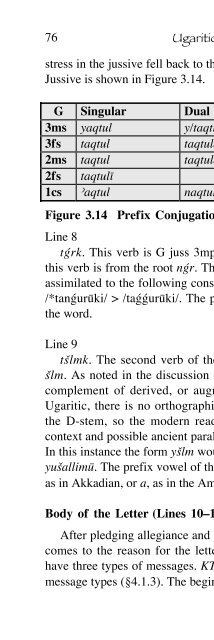A Primer on Ugaritic: Language, Culture, and Literature - enenuru
A Primer on Ugaritic: Language, Culture, and Literature - enenuru
A Primer on Ugaritic: Language, Culture, and Literature - enenuru
You also want an ePaper? Increase the reach of your titles
YUMPU automatically turns print PDFs into web optimized ePapers that Google loves.
76<br />
<strong>Ugaritic</strong> <str<strong>on</strong>g>Primer</str<strong>on</strong>g><br />
stress in the jussive fell back to the first syllable as in Hebrew. The<br />
Jussive is shown in Figure 3.14.<br />
G Singular Dual Plural<br />
3ms yaqtul y/taqtulaœ taqtuluœ<br />
3fs taqtul taqtulaœ taqtulna ?<br />
2ms taqtul taqtulaœ taqtuluœ<br />
2fs taqtulˆä taqtulna ?<br />
1cs }aqtul naqtulaœ ? naqtul<br />
Figure 3.14 Prefix C<strong>on</strong>jugati<strong>on</strong>: Injunctive: Jussive<br />
Line 8<br />
tgérk. This verb is G juss 3mpl. The double /gégé/ indicates that<br />
this verb is from the root ngér. The initial /n-/ of the root would be<br />
assimilated to the following c<strong>on</strong>s<strong>on</strong>ant since no vowel intervened:<br />
/*tangéuruœki/ > /tagégéuruœki/. The pr<strong>on</strong>ominal suffix, 2fs, completes<br />
the word.<br />
Line 9<br />
tsûlmk. The sec<strong>on</strong>d verb of the blessing is a D juss 3mp from<br />
sûlm. Asnoted in the discussi<strong>on</strong> of KTU 2.10, <strong>Ugaritic</strong> has a full<br />
complement of derived, or augmented, formati<strong>on</strong>s of verbs. In<br />
<strong>Ugaritic</strong>, there is no orthographic indicator of repeated letters in<br />
the D-stem, so the modern reader must decide <strong>on</strong> the basis of<br />
c<strong>on</strong>text <strong>and</strong> possible ancient parallels an appropriate interpretati<strong>on</strong>.<br />
In this instance the form ysûlm would be interpreted as a D juss 3ms<br />
yusûallimuœ. The prefix vowel of the D-stem may have been either u,<br />
as in Akkadian, or a, as in the Amarna Letters (see §7.6.2).<br />
Body of the Letter (Lines 10–18)<br />
After pledging allegiance <strong>and</strong> praying for well-being, the writer<br />
comes to the reas<strong>on</strong> for the letter. This part of the missive may<br />
have three types of messages. KTU 2.11 c<strong>on</strong>tains the first <strong>and</strong> last<br />
message types (§4.1.3). The beginning of the point of the letter is a


